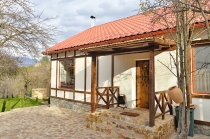
Marriott Tsaghkadzor
The hotel complex "Marriott Tsaghkadzor" offers a comfortable stay in the fresh air of Tsaghkadzor,...
Golden Palace Resort
"Golden Palace Resort-Spa" is the only officially recognized 5-star hotel in Tsakhkadzor, in...
Elegant
Elegant" hotel has stylish rooms where the guests can enjoy picturesque view of mountains and...
Villa Jrhogher
"Villa Jrhogher" is situated in the heart of Dilijan’s forests and is a perfect choice for a small group of friends, colleagues or family members to host up to 10 guests. Free private parking...
Belgium
.jpg&width=438&height=265)
| Capital | Brussels |
| Area | 132 545 km² |
| Population | 10 827 000 people |
| Official language | French, Dutch, German |
| Currency | euro |
| Climate | summer from +14°C to +19°C winter -1°C |
| Recommended type of holiday | sightseeing |
About country
Compact enough to be covered in a week and spirited enough to count as one of Europe's most under-rated destinations, Belgium does many things well, not least winning over sceptical visitors. If all that comes to mind is waffles and EU bureaucracy, then the reality - with its frothing beer, medieval steeples and simmering cultural mix - will be a pleasant wake-up call.
True, Brussels has more than its share of faceless political buildings, but take a closer look and you'll find a dynamic city big on café living and Art Nouveau, while Antwerp and (particularly) Bruges are both custom-made for picture postcards, the pair of them rich with finely crafted Middle Ages architecture. The country itself is split into two sections - Flanders (the predominantly Dutch-speaking north) and Wallonia (the predominantly French-speaking south) - which, when taken together, add up to a visitor package far greater in scope than Belgium is generally given credit for.



Sightseeing
There's more to Antwerp than its diamonds. The city is home too to the second largest harbour in Europe and - more importantly - an array of 16th and 17th century architectural marvels. Artist Peter Paul Rubens also lived in the city.
Belgium draws a huge number of modern history buffs, and the site of the Battle of the Bulge (a World War II conflict), situated close to the Luxembourg border, is a further reason why. The Bastogne Historical Centre has a strong collection of memorabilia.
The UNESCO World Heritage City of Bruges is perhaps the one destination in Belgium that - in terms of sheer beauty - transcends all others. Key attractions include the 14th-century town hall, the belfry tower and the Cathedral of the Holy Saviour. Sometimes referred to as the Pearl of the Ardennes, Spa is the town from which all spas take their name and, as such, makes for an essential stop-off for those who like their pampering. As well as offering a range of different treatments, it's also an attractive town in its own right. Belgium has a colourful roster of yearly festivals and celebrations, including the mid-Lent Carnival in Stavelot and the three-day Carnival de Binche. Arguably the most unmissable, however, is the pageantry-heavy Ommegang Festival in Brussels, which transports visitors back 500 years. Antwerp has long enjoyed a sparkling reputation as the world's diamond centre, and visitors can discover the city's prominence at the Diamant Museum (www.diamantmuseum.be). The venue features gem cutters and polishers at work, as well as outlining 400 years of history.


Traditions
In Belgium traditions are very much alive. All through the year e.g. children have many highlights to look forward to. One date eagerly awaited is december 6th. This is the feast of Saint Nicholas (in Flemish: Sint Niklaas or Sinterklaas). On that day this holy man comes down the chimney and leaves presents, sweets, chocolate and marzipan figures for the children. This feast of Sinterklaas (which is also very popular in Holland) is the most important of Belgium traditions.
In fact this is one of the Belgium traditions that have been exported to many other countries the world over. Santa Claus comes from this old Belgian feast. When you look at the two old men, they look exactly the same, apart from their clothes. Christmas is also big in Belgium. And Santa also shows up with Christmas, bringing more presents and sweets!
After Christmas comes New Year. It wouldn't be another of the Belgium traditions if there wasn't an abundance of food and drink. At midnight there is champagne and fireworks everywhere. More dates with special feasts are: january 6th, which is the celebration of the Three Wise Men, Easter, Carnival (beginning of spring), not forgetting the many folkloristic and historic celebrations and festivals in every town and city of the country.



Cuisine
Belgian cuisine is similar to French, based on game and seafood, although its critics claim that the country is a nation of gourmands rather than gourmets - that is, portion sizes are usually generous. Quality, however, is not sacrificed, and visitors can expect flavoursome, unpretentious dishes. Each region in Belgium has its own special dish. Butter, cream, beer and wine are liberally used in cooking. The nation is particularly famed for, among other things, its waffles, its chocolate, its beer and its mussels. Some claim that the frite, or deep-fried potato chip, was invented in Belgium.
Specialities:
• Moules frites (mussels and chips/French fries).
• Endives with Béchamel sauce.
• Ardennes sausages, ham, and pâté are renowned.
• Salade Liégeoise (salad with green beans, bacon, onions and vinegar).
• Stoemp (potato mashed with vegetables, often served with sausages).


.jpg&width=160&height=120)
Copyright © 2008 - 2024 kayq.org by Kayq.org. All rights reserved.



